A Month with Apple's Fusion Drive
by Anand Lal Shimpi on January 18, 2013 9:30 AM EST- Posted in
- Storage
- Mac
- SSDs
- Apple
- SSD Caching
- Fusion Drive
Fusion Drive: Under the Hood
I took the 27-inch iMac out of the box and immediately went to work on Fusion Drive testing. I started filling the drive with a 128KB sequential write pass (queue depth of 1). Using iStat Menus 4 to actively monitor the state of both drives I noticed that only the SSD was receiving this initial write pass. The SSD was being written to at 322MB/s with no activity on the HDD.
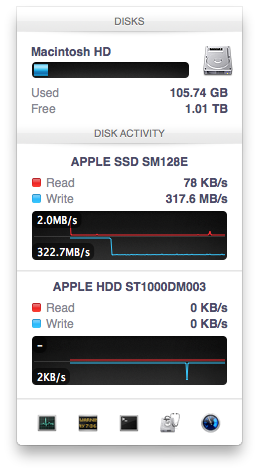
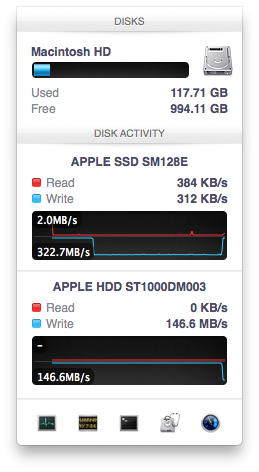
After 117GB of writes the HDD took over, at speeds of roughly 133 - 175MB/s to begin with.
The initial test just confirmed that Fusion Drive is indeed spanning the capacity of both drives. The first 117GB ended up on the SSD and the remaining 1TB of writes went directly to the HDD. It also gave me the first indication of priority: Fusion Drive will try to write to the SSD first, assuming there's sufficient free space (more on this later).
Next up, I wanted to test random IO as this is ultimately where SSDs trump hard drives in performance and typically where SSD caching or hybrid hard drives fall short. I first tried the worst case scenario, a random write test that would span all logical block addresses. Given that the total capacity of the Fusion Drive is 1.1TB, how this test was handled would tell me a lot about how Apple maps LBAs (Logical Block Addresses) between the two drives.
The results were interesting and not unexpected. Both the SSD and HDD saw write activity, with more IOs obviously hitting the hard drive (which consumes a larger percentage of all available LBAs). The average 4KB (QD16) random write performance was around 0.51MB/s, it was constrained by the hard drive portion of the Fusion Drive setup.
After stopping the random write task however, there was immediate moving of data between the HDD and SSD. Since the LBAs were chosen at random, it's possible that some (identical or just spatially similar) addresses were picked more than once and those blocks were immediately marked for promotion to the SSD. This was my first experience with the Fusion Drive actively moving data between drives.
A full span random write test is a bit unfair for a consumer SSD, much less a hybrid SSD/HDD setup with roughly an 1:8 ratio of LBAs. To get an idea of how good Fusion Drive is at dealing with random IO I constrained the random write test to the first 8GB of LBAs.
The resulting performance was quite different. For the first pass, average performance was roughly 7 - 9MB/s, with most of the IO hitting the SSD and a smaller portion hitting the hard drive. After the 3 minute test, I waited while the Fusion Drive moved data around, then repeated it. For the second run, total performance jumped up to 21.9MB/s with more of the IO being moved to the SSD although the hard drive was still seeing writes.
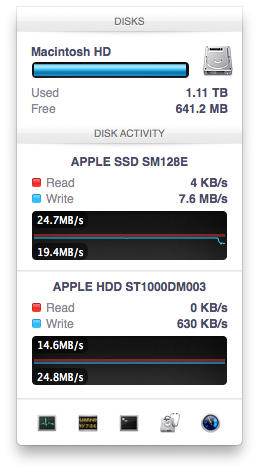
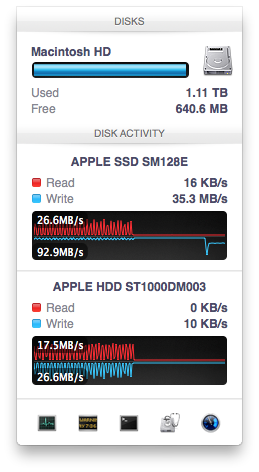
In the shot to the left, most random writes are hitting the SSD but some are still going to the HDD, after some moving of data and remapping of LBAs nearly all random writes go to the SSD and performance is much higher
On the third attempt, nearly all random writes went to the SSD with performance peaking at 98MB/s and dropping to a minimum of 35MB/s as the SSD got more fragmented. This told me that Apple seems to dynamically map LBAs to the SSD based on frequency of access, a very pro-active approach to ensuring high performance. Ultimately this is a big difference between standard SSD caches and what Fusion Drive appears to be doing. Most SSD caches seem to work based on frequency of read access, whereas Fusion Drive appears to (at least partially) take into account what LBAs are frequently targeted for writes and mapping those to the SSD.
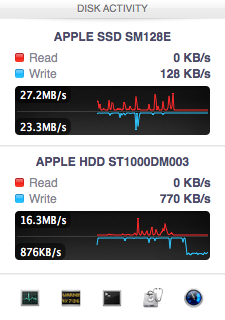
Note that subsequent random write tests produced very different results. As I filled up the Fusion Drive with more data and applications (~80% full of real data and applications), I never saw random write performance reach these levels again. After each run I'd see short periods where data would move around, but random IO hit the Fusion Drive in around an 7:1 ratio of HDD to SSD accesses. Given the capacity difference between the drives, this ratio makes a lot of sense. If you have a workload that is composed of a lot of random writes that span all available space, Fusion Drive isn't for you. Given that most such workloads are confined to the enterprise space, that shouldn't really be a concern here.










127 Comments
View All Comments
mutatio - Saturday, January 19, 2013 - link
Thanks, Anand, for the review. It would be interesting to see some comparisons to aftermarket Fusion setups as have been discussed in the comments here. e.g., How does the Fusion arrangement pan out with a 256GB or 512GB SSD on a Mac Mini? If my Mac were not a laptop I'd likely go for a Fusion setup but I'm not willing to take the hit in battery life while running an SSD and HDD (in the optical bay).philipma1957 - Sunday, January 20, 2013 - link
I have a 2012 quad 2.3 mini using a 512gb ssd and the oem 1tb hdd. It works very well. I used to run this mini with 2x 512gb ssds in raid0. They were in a pegasus r6 case hooked up via t-bolt. I now run this with the 1.5 tb fusion and a tm plus a clone backup in the thunderbolt case. I prefer the setup this way. I have been doing this for a week I have about 480gb on the 1.5tb fusion . It will take me a while but I will put about 1tb on the fusion I will then see how much it slows.pichemanu - Saturday, January 19, 2013 - link
A chart illustrating the possible impact of a USB 3 bottleneck on your test:http://tinypic.com/r/34fir7m/6
Suddenly the fusion drive no longer looks that good ;).
mrbreaker101 - Saturday, January 19, 2013 - link
I have a 2011 Macbook Pro with a 128GB Corsair Force 3 SSD and a 500GB hard disk. I decided to run the commands to make a fusion drive and so far, it's working, although the Force 3 isn't running that fast, despite being set to 6Gbps SATA.I'm going to install some new hardware in my iMac next. A 256GB Kingston Hyper X 3K SSD and 2TB hard disk (with thermal sensing cable from OWC, essential for iMac custom hard disk installs).
I'm not entirely sure I want to make a Fusion drive on the iMac as well. My current usage is about 500GB, with most of that being music files. On one hand, I have no need for mp3s using up my precious SSD space, even if I listen to them 1000 times a day. On the other, the simplicity of no longer having to worry about the locations of files is very appealing.
I also wonder, if I do a fresh install of Mountain Lion and then re-import my photos, media, etc, will Fusion Drive work better than by migrating over a Time Machine backup, which may fill the SSD with music, but leave apps on the hard disk?
ThomasA - Sunday, January 20, 2013 - link
I have no experience with the 'fusion drive' but wonder about a clone/backup method, given the circumstances.I do have a MBPro with a 256GB SSD paired with a 'spinning' HD (replacing the DVD).
I followed instructions offered by a Matt Gemmell, re: moving the 'home folder' to the HD. This allowed a backup clone of the SSD & a separate copy of the HD files.
http://mattgemmell.com/2011/06/21/using-os-x-with-...
twotwotwo - Sunday, January 20, 2013 - link
Awesome that Anand can't resist throwing in some sort of enterprise-y benchmarks in a review of a consumer thing. :)I'm sort of curious how the enterprise caching solutions work on the real-world database-y workloads I've seen AnandTech do measurements of before. That's super workload- and software-dependent (how big is your working set? how fat is your long tail of requests outside it?) so AT's results wouldn't directly apply to the world at large--still, one data point is a big step ahead of zero. :)
(It also seems to be increasingly a thing to design enterprise stuff with data 'intelligently' routed by to SSD or HDD by application-aware software [Evernote has done this, say, and Amazon offers SSDs and HDDs in separate instance types], rather than routing with magic at the block device layer. Still, would be awesome to know anything at all about how effective the automagical caching is in databases.)
And, unrelatedly, I'm sure Apple will get rid of the Pros with HDDs when they can, and I hope most other manufacturers do, too. You don't need TBs of internal storage now (esp. if videos are streamed, cloud storage an cheap externals exist, etc.) and Flash is good for speed, size and weight, durability (no head crashes!), etc.
carraj - Saturday, January 26, 2013 - link
Machine: 2010 15" MacBook Pro, 8 GB RAM. Disk controller is SATA II, so pointless using SATA III devices.Installed 750 GB WD Scorpio Black HDD in optical drive bay using Data Doubler bracket (/dev/disk1).
Installed 240 GB OCZ Vertex Plus R2 SSD in HDD bay (/dev/disk0).
Both were formatted as JHFS+ using Disk Utility. A Recovery HD partition was created on the HDD using Carbon Copy Cloner as /dev/diak1s3.
Fused /dev/disk0s2 and /dev/disk1s2 together giving ~1 TB Fusion Drive.
Performance is incredible, though not quite as fast as my mid-2012 13" MacBook Air with 256 GB SATA III SSD in tests. Here are the results from Xbench 1.3 (the Fusion Drive clocks in at about 2/3 of the performance of the pure SSD, despite having a 3 Gb/s SATA II interface rather than a 6 Gb/s SATA III interface):
15" MBP with 240/750 GB SATA II Fusion Drive:
Disk Test 277.85
Sequential 180.25
Uncached Write 412.52 253.28 MB/sec [4K blocks]
Uncached Write 278.11 157.36 MB/sec [256K blocks]
Uncached Read 89.26 26.12 MB/sec [4K blocks]
Uncached Read 201.26 101.15 MB/sec [256K blocks]
Random 606.00
Uncached Write 555.66 58.82 MB/sec [4K blocks]
Uncached Write 531.52 170.16 MB/sec [256K blocks]
Uncached Read 1566.27 11.10 MB/sec [4K blocks]
Uncached Read 438.38 81.34 MB/sec [256K blocks]
13" MBA with 256 GB SATA III SSD:
Disk Test 431.86
Sequential 278.39
Uncached Write 720.45 442.35 MB/sec [4K blocks]
Uncached Write 479.45 271.27 MB/sec [256K blocks]
Uncached Read 106.55 31.18 MB/sec [4K blocks]
Uncached Read 662.54 332.99 MB/sec [256K blocks]
Random 962.48
Uncached Write 751.67 79.57 MB/sec [4K blocks]
Uncached Write 748.11 239.50 MB/sec [256K blocks]
Uncached Read 2147.57 15.22 MB/sec [4K blocks]
Uncached Read 977.31 181.35 MB/sec [256K blocks]
kamaaina - Tuesday, February 12, 2013 - link
I am very happy after 6 weeks with my DIY Fusion Drive in my MBP. Replaced the optical drive as well and moved the HDD 500GB Momentus XT into the DVD HDD tray, and put an Intel330 240GB SSD in. Fused together, it runs really well. I followed the video on Youtube from Tomas Villegas, took me a only a few minutes. Awesome improvement!qzyxya - Saturday, February 16, 2013 - link
Is there a way to get this for windows? I'd love to have this. Like buy a 128gb ssd and use it for caching with my 3tb samsung 7200.14 hard drivenavss - Friday, April 26, 2013 - link
Great read, personally I like the thought of getting the Mini with the 256GB SSD + adding another 2-3TB HDD for relatively cheap and using that terminal command to set up the Fusion Drive.Also Anand, if you're going to be taking screenshots of programs on the Mac: Cmd+Shift+4+(hover over the program you want a screenshot of) then hit the spacebar, you'll get much nicer screenshots.